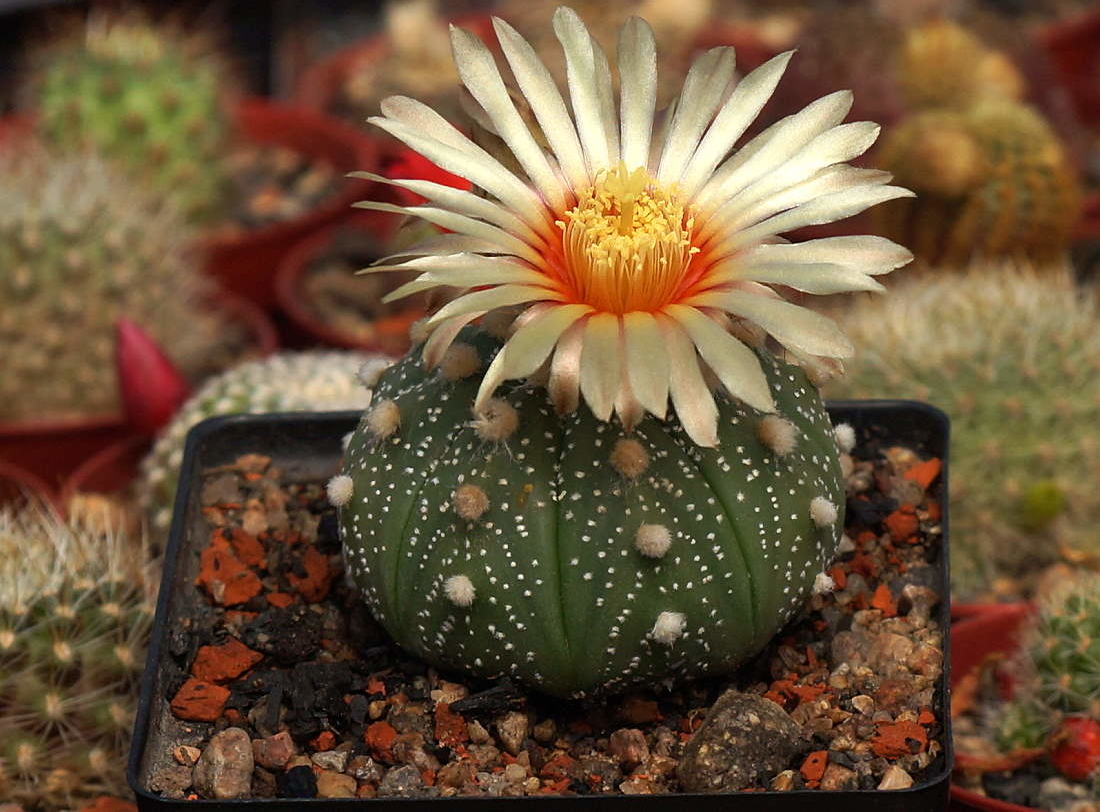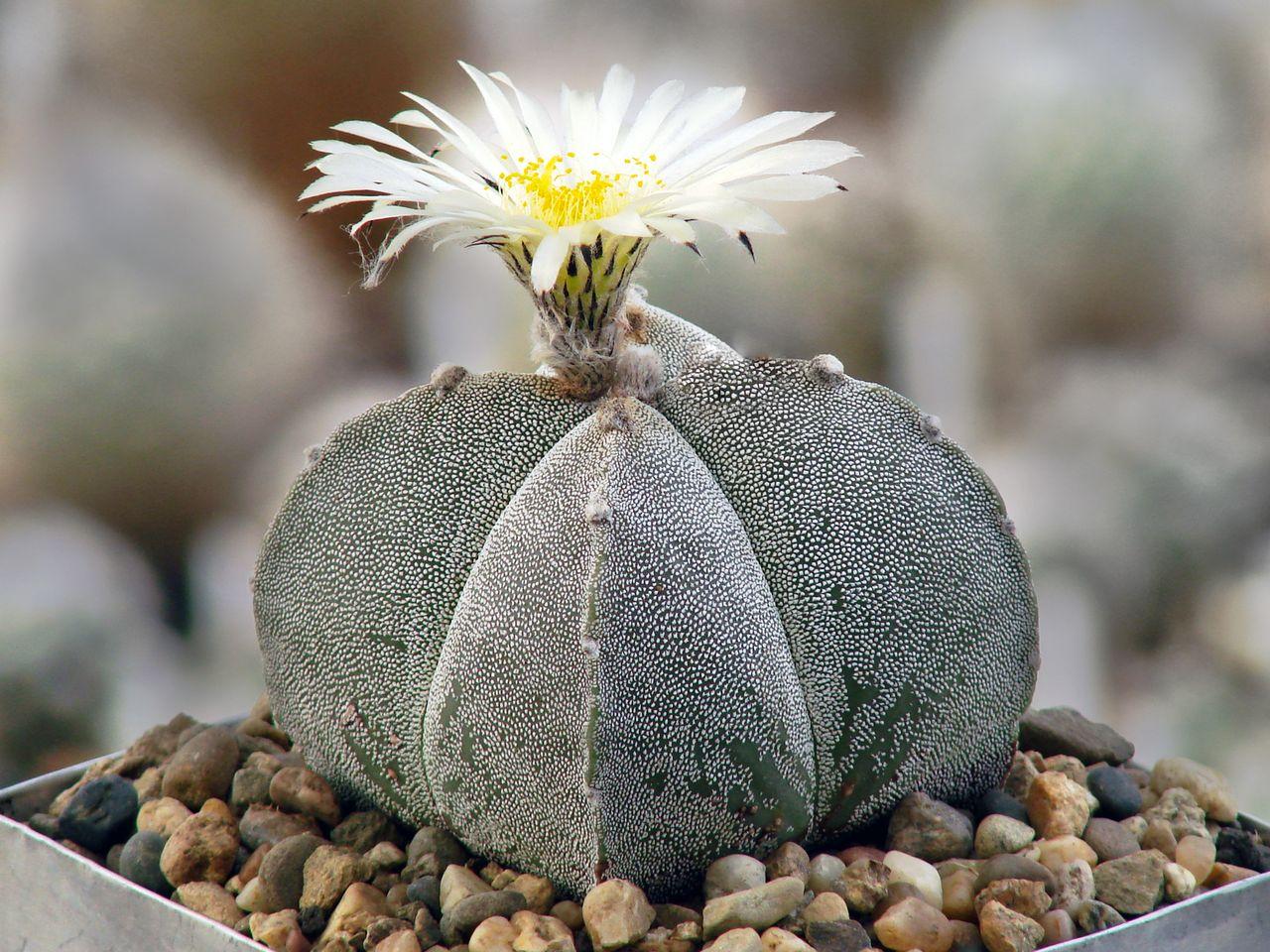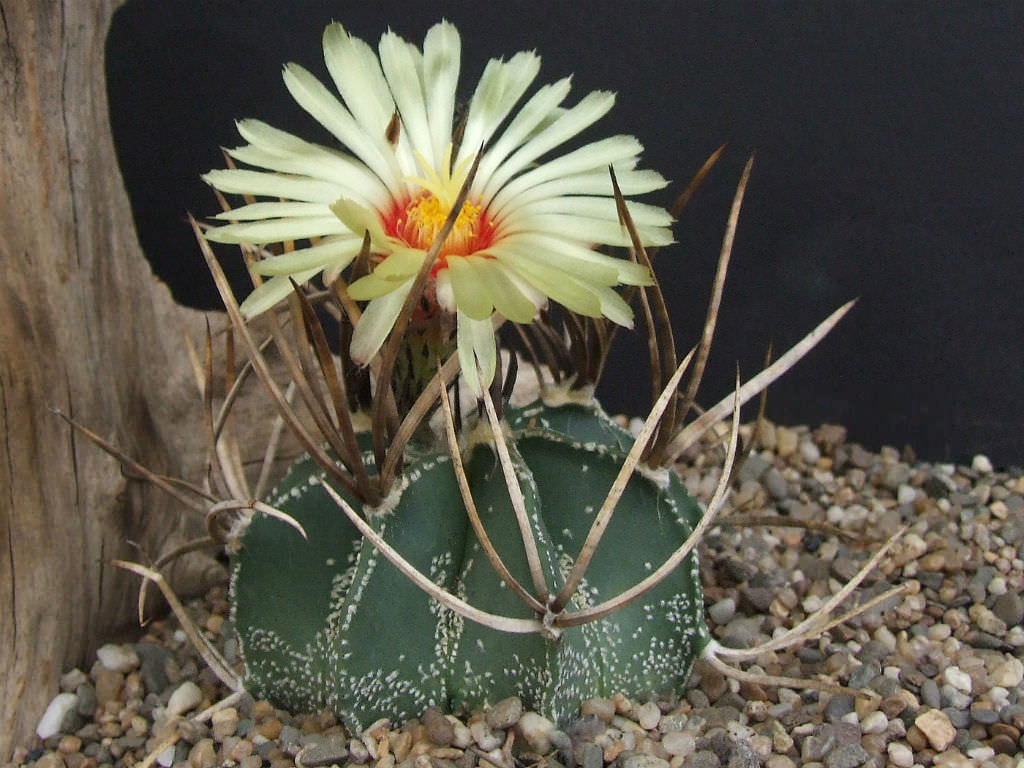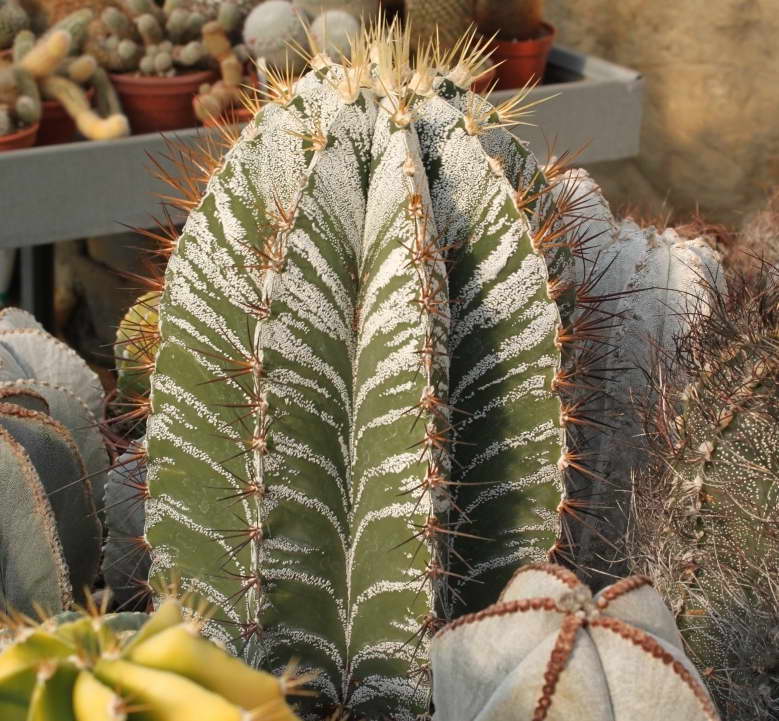Possible Content Issues
Sometimes inexperienced cactus owners simply do not know what to look for. Here are some situations that should alert an amateur cactus grower.
Complaints:
-
Unusual stem shape. Possible reasons. The plant lacks light or is too hot in winter.
-
The stem near the ground is soft, sluggish, often wrinkled. Cause. Waterlogging of the soil. What should I do? Reduce watering, monitor soil condition.
-
The cactus grows poorly or has completely stopped growing. The most likely reason: improper watering regime, excess moisture in winter or insufficient moisture in summer. See also pests. What should I do? Change the watering mode.
- Soft patches of reddish or brown color appear on the stem. Cause. Most likely this is stem rot, which occurs when over-watering. What should I do? Cut out damage, change the watering regime. It is recommended to disinfect the soil.
Breeding these wonderful plants with very beautiful flowers is not without questions and difficulties. Using the new information, an amateur cactus grower will be able to become an expert in the cultivation of Astrophytum cacti in a short time. Let your collection of cacti grow and please you and your loved ones!
How to feed and transplant astrophytum
For each plant, feeding and correct transplantation are important. The astrophytum cactus also needs these two factors.
For feeding, it is best to use special formulations for succulents. You can buy them at a flower shop. Experienced indoor plant lovers recommend feeding cacti once a month during the entire warm period.
These representatives of the flora should be replanted annually. Even with proper feeding, the soil is depleted, therefore it is recommended to replace it annually. When transplanting astrophytum, it should be borne in mind that it needs more calcium in the soil than other plants. Therefore, granite or marble chips are mixed into the ground. If they are not there, then a simple eggshell will do.
Growing astrophytums is easy. They require a minimum of human effort and time. Therefore, they are very fond of busy people who find it difficult to pay much attention to flowers.
How to take care at home?
Caring for astrophytum myriostigma is not difficult. Indeed, in the natural environment, it grows in rather unfavorable conditions: sultry heat, lack of moisture.
Temperature
- Summer: high air temperature is not a problem for the plant. It is reasonable to place astrophytum in the open air - balcony, terrace, protecting it from precipitation.
- Autumn: the flower prepares for rest. Reduce the temperature gradually.
- In winter: a sufficiently low temperature is required. Up to ten degrees.
- Spring: temperature gradually rises to high summer degrees.
Watering
Watering is preferable from the pallet, also taking into account the season:
- Summer: as the soil dries up.
- In spring and autumn: once or twice a month.
- In winter: watering is not required for astrophytum.
Overflow promotes decay of the roots and base of the stem.
Priming
The substrate for astrophytum consists of coarse sand, peat, sod and deciduous soil in equal parts. When planting a plant, a drainage layer is laid on the bottom of the flowerpot.
Top dressing
Produced from mid-spring to mid-autumn, once every 3-4 weeks. Special fertilizers for cacti are used as nutrients.
Pot
The size of the container is selected depending on the size of the plant. For small specimens, a pot with a diameter of 6 - 8 cm is usually taken. Considering that the root system of astrophytum does not grow deeper, the flowerpot needs a flat one.
Transfer
Important! Transplant during the growth period. A transplant during hibernation can cause decay of the roots damaged during the procedure .. Transplant is carried out only if urgently needed, no more than once every 3 to 5 years
More often if necessary. Astrophytums do not tolerate transplantation
The transplant is carried out only in case of urgent need, no more than once every 3 to 5 years. More often if necessary. Astrophytums do not tolerate transplantation well.
The reasons for the transplant can be:
- The overgrown root system filled the entire volume of the container.
- Damage to the root system by rot or pests.
The correct astrophytum transplant is performed in this order:
Distribute the drainage in the container in a layer of 2.5 - 3 cm.
Fill the container one third with a special cactus substrate.
Carefully remove the cactus from the old pot and pay special attention to the root system: Gently clean the roots of the soil.
Inspect the root collar and roots for decay and pests.
Remove rotten roots.
Gently spread the roots and place in a flowerpot, gradually adding soil between them.
Pour the soil up to the root collar and place the top drainage in a small layer.
Do not sprinkle the root collar! This will cause it to rot. If the plant has lost a lot of roots during transplantation, more river sand should be added to the soil.
Wintering
Astrophytum has a dormant period in winter. To ensure the rest of the plant, the room must be ventilated, dry with a temperature of 5 - 10 degrees.
After the establishment of sunny weather, spraying and fractional watering with water at room temperature is carried out.
Home care
"Star Cactus" is a tropical plant, therefore it loves bright lighting. However, too scorching sun rays can be detrimental to astrophytum. It is necessary to place the pots on the eastern or southern windowsills.
Table 1: Growing conditions
| Season | Temperature regime | Air humidity | Lighting |
| Winter | Thermometer marks should not exceed + 12 ° C | Astrophytum loves dry air and does not need to be sprayed | Artificial lighting is not required for astrophytum |
| Spring | A gradual increase in temperature to high summer marks is recommended. | After wintering, the plant must be gradually accustomed to the sun. Shade the cactus at lunchtime | |
| Summer | The optimum room temperature should be at least +25 ° C. | In the summer season, flowerpots with succulents can be taken outside, but they should not be in the rain or in a draft. | |
| Autumn | The plant prepares for dormancy, the temperature is gradually reduced to winter degrees | Good lighting needed |
Watering and feeding
Astrophytum does not need frequent watering. In the summer, it is irrigated as the soil dries up, in spring and autumn - twice a month. In winter, the cactus is not watered. For humidification, use settled or filtered water at room temperature.
From March to November, the houseplant is fed with complex fertilizers for cacti. The dose indicated in the instructions for the drug is halved. In the winter season, astrophytum does not need feeding.
Transfer
The cactus is transplanted only when it becomes cramped in the pot. Transfer is performed by transshipment. You can buy soil for succulents at a specialized store or make your own. It should include:
• leaf land (1 share);
• sod land (1 share);
• river sand (1 share);
• charcoal (¼ share).
The astrophytum pot should be wide but shallow. At its bottom, it is necessary to lay out a drainage layer (expanded clay or small pebbles). The root collar of a cactus should not be buried. It should be flush with the soil substrate.
Popular varieties (cultivars)
Astrophytum capricorn (Astrophytum capricorne)
Wonderful view of Astrophytum. In conditions close to natural it can reach a height of 30 cm and a diameter of 17 cm.At a young age, it has a round shape, as it grows up, it stretches into an ellipsoid. The round barrel is usually divided into 8 parts, but there are various deviations. The specks completely cover the stem of the plant, almost overlapping the natural green color.
On the upper part of the ribs there are areoles, pubescent with hairs, from which long spines grow. 6-7 spines, almost ten centimeters, from each areola, twisted like goat horns. From this came the name of this variety. In adulthood, they entangle the entire trunk. Flower buds open in early summer or late spring. The color of the 6 cm petals ranges from bright to light yellow.
A. capricorn
Astrophytum speckled (Astrophytum myriostigma) myriostigma
This Astrophytum has a smooth trunk covered with velvet specks. Most often it has 5 pronounced ribs, which is why it was nicknamed by flower growers "Bishop's miter". With age, it reaches a circumference of 20-25 cm. There are areoles with villi on the ribs.
This cactus blooms with bright yellow flowers, pointed at the tips of the petals with a brown border. A rounded pistil and protruding stamens are located inside the flower. Blooms in summer, but only 2-4 days. When ripe, the fruit pods reveal stellar figures, which also looks very decorative. Some varieties have no speck at all. But the biggest advantage is that all subspecies are very unpretentious to care for.
A. speckled
Star astrophytum (Astrophytum asterias)
Originally from areas of northern Mexico. This cactus has a slow growth rate. Its trunk is spherical, slightly flattened downward. Ribs are very poorly defined and there are only about 6-8 ribs. The color of the barrel is brown-green. The original areoles are located approximately in the middle of the ribs. There is a white speck around them. The areoles themselves have an even round shape, from which long, sharp spines of brown grow. From the areoles, the cactus produces flowers of a light yellow color with a red center, the diameter of which is 7 cm. They open in summer and only in the daytime. This species served as the basis for the development of dozens of new varieties.
A. star-shaped
Astrophytum coahuilence (Astrophytum coahuilence)
Differs in life expectancy. With proper care, it grows in a circle of 25 cm and a height of more than a meter. In young plants, the ribs are deep and clear, but they compare with age.
The surface of the cactus, which has a rich green color, is dotted with gray dots, and completely devoid of thorns. Areoles become visible only with the beginning of flowering. This Astrophytum has lemon-colored flowers with an orange-red center.
A. coahuilense
Decorated astrophytum (Astrophytum ornatum) ornatum
This cactus is not demanding to care for. In indoor conditions, it grows up to 30-40 cm. The specks are located in interesting almost completely horizontal stripes. The specks are mainly located on the ribs of the trunk and give the impression of a plush pattern. It has brown spines.
It blooms late, only in the 6th year of life, if its height has reached 15 cm. Flowers depend on the variety of this plant. Most often, flowers have light yellow shades of different saturation.
A. decorated
Astrophytum Kabuto or Super Kabuto (Astrophytum Сabuto)
Super Kabuto is a whole family of randomly cracked Astrophytum patterned with some other kind. The Japanese M. Takeo found a neglected mother plant in one of the nurseries in America. Having put the plant in order, he waited for fruiting and planted seeds. Of the seedlings, only about 30% inherited maternal characteristics. Unfortunately, further hybrids very rarely repeat the distinctive features that were originally.
The following signs remained unchanged: the Super Kabuto variety - White Snow, has trunks completely covered with white specks, and the Zebra or Tiger variety, where specks are lined up in various stripes.
A. Super Kabuto
General information about the plant
The genus of astrophytums includes 10 species. Their homeland is the hot, arid regions of South America and Mexico. In the wild, they grow large - up to 1 meter. As an indoor flower, astrophytum is compact - no more than 10 cm in diameter. The number of ribs varies from 3 to 10.
Astrophytum is a spherical cactus of green, grayish-green or speckled color. The spines are large or absent altogether. An interesting feature is the presence of small hairs on the stem.
Blossom in summer. Flowers of yellow shades up to 8 cm in diameter bloom at the crown of the head. The pharynx of the flower is sometimes colored red. Flowers live no more than three days. In their place, oblong fruits are formed. After ripening, their lobules open. Inside are brown seeds.
Interesting! Astrophytum grows slowly, does not tolerate high humidity. The plant can suddenly die for no apparent reason. It blooms only with proper care. Decorated and speckled astrophytum are considered the easiest to grow.
Seed propagation
Astrophytums do not have "children" (lateral processes), they reproduce only by seeds that retain their germination for 1-2 years.
- seeds are sown in the ground in spring at an air temperature of + 22 °;
- before sowing, soak for 10 minutes in a weak solution of potassium permanganate, and then dry;
- the best soil: a mixture of river sand, leaf earth and crushed charcoal in equal proportions;
- you can cover the pot with a bag or jar to speed up the emergence of shoots;
- seeds sprout in a few days;
- before and after sprouting, the soil must be moistened, but moderately, if you overdo it, the plants will die.
We offer you to watch the video of sowing astrophytum: “Reproduction of cacti by seeds. Care of astrophytum seedlings "
Features of selection in the open field
Astrophytums feel comfortable outdoors only in warm regions, where there is no frost in winter. In regions with a temperate climate, planting in open ground is possible only in large greenhouses. Special comfortable climatic conditions for cacti are created. The features of care and reproduction in special greenhouses are no different from growing astrophytums at home on a windowsill.
When and how does it bloom?
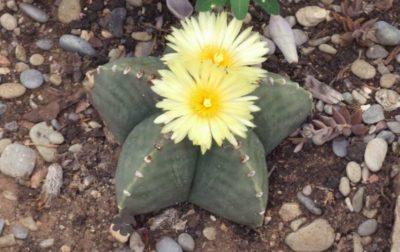
All astrophytums bloom at an early age. An exception is ornatum, flowers will appear on it only if the height of the cactus reaches 15 cm, as a rule, for this it needs 6 years.
Yellow flowers (in some species with a red center) always appear at the top. They last 2-3 days, after which they quickly fade. In their place, a green oval box with brown seeds is formed. When they are ripe, the capsule opens up in the shape of a star at the top of the stem.
What if the buds are not forming?
- Perhaps the cactus is still too young, you should not wait for the plant to bloom earlier than 3 years of age.
- For astrophytums, wintering at the right temperature is very important, at this time future flowers are formed. Most often, the reason for the lack of flowering can be a too high or low wintering temperature.
- Abundant watering can lead to decay of the roots and stem, here the cactus is not up to flowering if it dies.
- It is necessary to provide the astrophytum with proper care in compliance with all conditions of temperature, watering, lighting and feeding, only in this case the cactus will delight you with flowers.
Caring for the astrophytum cactus at home
When caring for astrophytum, a cactus needs bright lighting with direct sunlight in both summer and winter, as well as dry air. The plant can be placed on the windowsill of a window in the south or southwest direction. They hibernate in dry and cold conditions. For the winter, the plant is placed in a bright room with a temperature of 6-10 ° C. In summer, plants require warmth and a lot of sun, good ventilation. The substrate is common for cacti.
In contrast to most cacti, astrophytums love calcareous soil, a lot of sun and heat, they tolerate watering well with settled water.
Water it in moderation. In winter, during the dormant period, do not water the astrophytum, and maintain the temperature at 7 - 10 ° С. In summer, feed with fertilizers for cacti. Transplant after 4 or 5 years.
From May to September, when caring for astraphitum at home, a cactus needs abundant watering. Starting in October, it is gradually reduced. In winter, they do not water at all. In summer, plants are fed with fertilizers for cacti. At a young age, astrophytum is transplanted annually. Mature plants - once every 4-5 years in spring.
Propagated by seeds.
When transplanting, do not bury the root collar or sprinkle it with earth.
Description
In nature, this perennial succulent, representing the Cactaceae family, is found in the Mexican deserts and in the southern regions of the United States. In ferocactus, the root system does not have a high level of development. The rhizome does not grow in depth, but in breadth. Thick white roots penetrate 3-20 cm into the soil.

The stem is fleshy. It can have different shapes - from round and spherical to oblong. It has a dense skin with a characteristic shine. She has a dark green or blue. As a rule, the stem is single. In some cases it reaches 4 m in height and 0.8 m in width. Sometimes you can find real colonies of branched species.

The stem is decorated with triangular ribs running in a vertical plane. They have flat areoles decorated with whitish pubescence and a bunch of needles. Towards the top, the frequency and volume of the fluff increases, and at the end there is a depression, as can be seen in the photo of ferocactus.

Usually, the areola contains no more than 15 hooked needles. Spines 1-13 cm long can be thin, wide, and have a flattened base. The plant blooms in summer, but it is difficult to achieve this at home. Usually, flowers are pleasing with ferocactus with a height of 25 cm.

The core is yellow, contains anthers and ovaries. The resulting fruits are oval. They have a dense and smooth skin. Contains several black seeds.

general information
These cacti are well kept at home and are very common. They are spherical in shape with vertical grooves. The stem color is greenish-gray, green, often with a light speck or spotted. In the middle of the edges, there are characteristic bunches of fluffy hairs.
For some species of Astrophytum cacti, thorns are characteristic, but most do not. Blooms in summer, large flowers are located at the top of the stem. The color of the petals is yellow, from light to intense. The core of the flowers may be red.
Homeland
Astrophytum is native to the hot and dry states of Mexico and the United States. These cacti are unpretentious and hardy, love sunlight, tolerate the absence of moisture well, but are sensitive to its excess.
Pests and diseases
The most common pests of this type:
• mealybug,
• root worm,
• shield.
Signs of defeat and methods of struggle
Mealybug - visible to the naked eye. A waxy white coating appears on the cactus, resembling cotton wool. You can see the discharge of "honeydew" - a sugary liquid.
Most often, the intercostal grooves of cacti or young parts of the stem are affected.
Various insecticides are used. Popular methods have proven themselves well: washing the damaged areas with soapy water, onion or garlic juice with soap, and calendula tincture.
The rootbug is smaller than the mealybug, it lives on the roots or near the soil surface. It is difficult to notice its presence, but one of the indirect signs of infection will be that the cactus stops growing.
It is recommended to carefully release the roots of the cactus and examine them. White bloom speaks of infection.
Among the complex of control measures, insecticide treatment is most effective, but hot root baths often give a good effect. The roots are rinsed in water at a temperature of 70-80 ° C, then powdered with sulfur powder. Before planting in the ground, they are dried for about two days.
Scale - small insects, from 0.5 to 5 mm, covered on top with a kind of round or oval shield. Destroyed with insecticides, after removing all noticed pests.
It is necessary to expand the range of the territory treated with drugs, since pests can be within a radius of up to several meters from plants.
Astrophytum types and photos
Astrophytum Thousand-speckled - the stem of the cactus is devoid of thorns and has five pronounced faces. The plant reaches a height of up to 25 centimeters. On the surface of the stem, there are small villi and numerous specks. Flowering time is in the summer. Inflorescences are large with light yellow double petals.

Astrophytum Mirostigma is a solitary cactus with a spherical green stem covered with a silver speck. As they grow, the stems become cylindrical. They have 3 to 5 vertical, pronounced ribs. This variety has no thorns. Inflorescences are large, yellow, funnel-shaped.

Astrophytum Ornatum - depending on the variety, the stem can have a different number of faces and shades. Some cacti have a green tint, while others are covered with light specks. This type of astrophytum is one of the fastest growing. It has sparse, short spines. Inflorescences are large, bright yellow with silk petals.

Astrophytum Decorated - the plant reaches a height of up to 40 centimeters. The stem is dark green with specks merging into horizontal stripes located on the ribs of the trunk. This variety has brown spines. The plant blooms from 6 years of age. Inflorescences are large, light yellow.

Astrophytum Asterias (Astrophytum Star) - the birthplace of culture is Northern Mexico. This variety is a slow-growing one. It has a spherical, slightly flattened barrel. Ribs are poorly expressed and have a number of 6 to 8 pieces. The color of the cactus is greenish brown. There are white specks on the ribs of the trunk. The plant has sharp spines, brown in color. Inflorescences are large, yellow with a red core. Flowering time is in the summer.

Astrophytum Capricorn - the plant can reach a height of up to 30 centimeters, while having a diameter of up to 17 centimeters. The trunks of young plants are round in shape, and as they grow, they become elliptical. The trunk has eight ribs and is covered with numerous light specks. The spines of this cactus species are long, curled, resembling goat's horns. Upon reaching the age of seven, the thorns completely encircle the trunk of the cactus. The culture blooms from late spring to early summer. Inflorescences are large, bright yellow.

Astrophytum Capricorn
From other varieties of cacti, this variety differs in unusual, long spines, which are bent in the form of horns. The plant has a spherical stem and can grow up to 25 centimeters as it grows. The dark green trunk with small, yellow specks has up to eight ribs. Inflorescences are bright yellow, large. The flowering time of the culture falls on the summer. In the wild, the cactus grows in northern Mexico.

Astrophytum Polyphthic - grows mainly in the mountainous regions of northern Mexico. In height, it can reach up to 100 centimeters, with a diameter of up to 20 centimeters. The cactus has a spherical stem that becomes cylindrical with age. The variety has no thorns. The trunk is covered with small silvery villi in the form of small specks. A plant can have from three to eight ribs. Inflorescences are large, bright yellow with a silky sheen.

Astrophytum Speckled - has a smooth trunk covered with velvet spots.The plant has five distinct ribs. In diameter, with age, the culture reaches 25 centimeters. Inflorescences are medium, bright yellow. After flowering, boxes with fruits begin to ripen, which, after opening, resemble stars.

Astrophytum Kabuto - This type of cactus originated in Japan. The plant reaches a height of 8 centimeters and has a spherical stem with numerous white specks that overlap the native dark green color. Ribs are poorly defined. Their number is from three to eight pieces. The inflorescences of the culture are large, bright yellow with a red center. The flowering time of the cactus is in the summer.

Astrophytum Medusa's Head - the plant reaches a height of 19 centimeters. The stem has a cylindrical shape, dark green with fine coffee or reddish bristles. On it are many long processes that resemble the tentacles of a jellyfish. The cactus has small, thin spines. Inflorescences are medium, light yellow. After the culture has flowered, egg-shaped seeds are formed.

Reproduction methods
Florists practice several effective methods of independently obtaining a new plant. Possible breeding options for "African chamomile" are described below.
Cuttings
If a perennial hibernates indoors in autumn, then the gardener in February is recommended to cut off lateral shoots from the culture, the length of which should be within 6-10 centimeters. For work, you must use a sharp, disinfected knife. The cut points in the mother culture and cuttings are treated with coal powder; if there is green mass at the ends, it is recommended to remove it. Then the collected material is placed in a container with warm water for sprouting roots. Any growth accelerator that is added to the liquid can be used to stimulate. The water in the container must be changed regularly, the temperature in the room must be maintained in the range of + 20-22 degrees.
After the roots appear, the petioles are planted in pots with a special soil mixture. It is most correct to cut and germinate osteospermum in a substrate consisting of humus, fine sand and garden soil.
Some gardeners practice the cuttings method, skipping the intermediate stage of keeping the separated parts of the flower in water, rooting shoots directly into a container with earth. The flower thus multiplies only if a mini-greenhouse is created with good illumination, moderate moisture and regular ventilation.


Seeds
To grow a crop from seeds, planting material is collected or purchased. Selected seeds for seedlings must be rooted in the ground in March-April. Before deepening them, the seeds are kept in a damp cloth or in a container with a little water.

If you collect or purchase fresh seeds, it is recommended to germinate them in special peat tablets or in ordinary plastic containers. To avoid damage to young crops when planting together, each flower should initially be planted in a separate container.
The seeds must be deepened no more than 5 mm into the ground, after which the soil must be moistened with a spray bottle, and a mini-greenhouse must be made using any covering material that allows light to pass through. Seedling care comes down to regular airing and moisturizing. The optimum air temperature in a room with osteospermum seedlings will be + 20-22 degrees. The film can be removed from the plants when the first shoots appear on the surface. Further, young crops should grow in a well-lit area. As soon as the plants get stronger, they must be gradually accustomed to fresh air by placing containers with young flowers outside for a while, gradually increasing its duration. Landing in open ground can be carried out in the spring, when the temperature outside will not drop below +15 degrees, even at night.
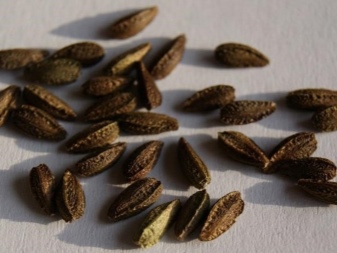

Dividing the bush
Osteospermum can also be propagated by dividing an adult culture into several parts. To do this, you need to dig a flower out of the ground, divide it into the required number of parts containing the roots. New crops can be dug into the soil immediately.


